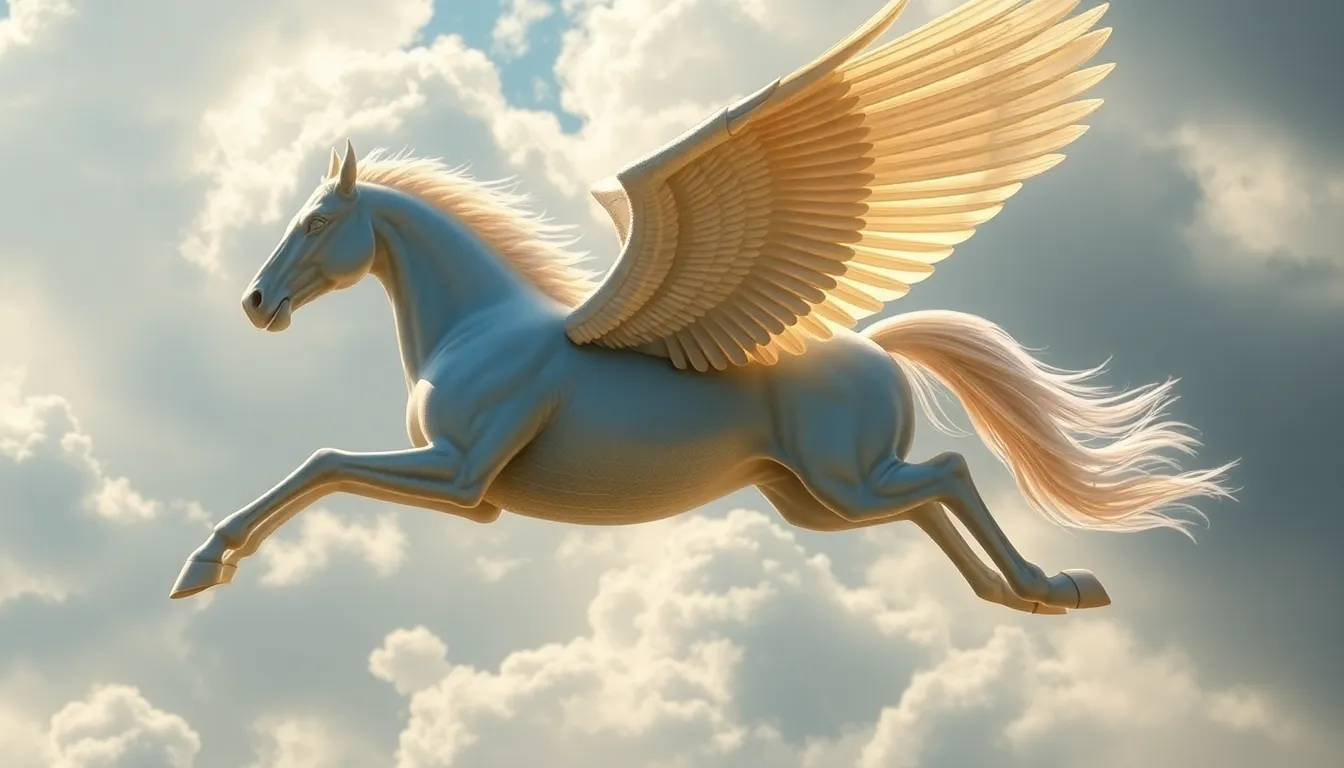The Flight of Pegasus: Myths About His Incredible Speed
I. Introduction
Pegasus, the majestic winged horse of Greek mythology, has captivated the imagination of people for centuries. Born from the blood of the Gorgon Medusa, Pegasus embodies not only beauty and grace but also incredible speed. His legends are steeped in tales of swift flight, symbolizing freedom and the pursuit of lofty ideals. This article aims to delve into the myths surrounding Pegasus, exploring his origins, his legendary speed, and the cultural impact he has made throughout history.
II. The Origins of Pegasus
The story of Pegasus begins with the tragic tale of Medusa, a once-beautiful maiden transformed into a monster. According to myth, when Perseus beheaded Medusa, Pegasus sprang forth from her blood, a symbol of rebirth and transformation. This extraordinary birth connects Pegasus to several key figures in Greek mythology, including:
- Perseus: The hero who tamed him.
- Bellerophon: The mortal who rode Pegasus in his quest to defeat the Chimera.
- Athena: The goddess who guided and aided Bellerophon.
Pegasus’s birth signifies not only the duality of beauty and terror but also highlights the interconnectedness of various mythological narratives. In ancient culture, Pegasus was often seen as a symbol of inspiration, creativity, and the arts, particularly the Muses.
III. The Myth of Pegasus’s Speed
Pegasus is renowned for his incredible speed, which is celebrated in numerous myths and stories. One of the most popular tales is his flight with Bellerophon as they soared through the skies, showcasing his agility and swiftness. His speed is often compared to other mythological creatures, such as:
- The swift-footed Hermes, the messenger of the gods.
- The winged creatures like the Harpies and the Griffin.
The impact of Pegasus’s speed on his adventures cannot be understated. His ability to fly rapidly allowed him to escape danger, traverse vast distances, and engage in heroic feats. This speed also made him a favored companion of the gods, particularly Zeus, who utilized Pegasus to carry thunderbolts and aid in his celestial duties.
IV. Pegasus in Art and Literature
The image of Pegasus has been immortalized in ancient art, often depicted in sculptures, pottery, and frescoes. His graceful form and powerful wings symbolize not only speed but also the ethereal nature of divine beings. In modern literature and media, Pegasus continues to inspire authors and creators, appearing in:
- Fantasy novels like “Percy Jackson & The Olympians.”
- Films such as “Clash of the Titans.”
- Artworks that reinterpret his image in contemporary contexts.
Artistic interpretations of Pegasus often emphasize his speed, capturing the essence of flight and freedom. These depictions shape the perception of Pegasus as not just a creature of mythology, but a lasting symbol of aspiration and agility.
V. The Science of Flight and Speed
Analyzing Pegasus’s speed through a scientific lens raises intriguing questions about the nature of flight in mythology. While Pegasus is a fantastical creature, the physics of winged animals offers insight into the feasibility of his legendary speed. Key points include:
- The mechanics of flight: Understanding lift, drag, and propulsion.
- Comparing mythical creatures to real-world birds, such as the peregrine falcon, known for its speed.
- The symbolism of flight in human culture and its representation in various mythologies.
Contrasting mythological speed with real-world avian capabilities reveals the imaginative nature of Pegasus’s legend, as well as humanity’s desire to transcend earthly limitations through flight.
VI. Cultural Impact and Legacy
Pegasus has made a significant impact on contemporary culture, appearing in various forms of media including:
- Movies and television shows that draw on Greek mythology.
- Literature that incorporates mythological themes and characters.
- Artwork that reimagines Pegasus in modern contexts.
The fascination with Pegasus reflects our enduring interest in speed and freedom. Myths surrounding him shape our understanding of these concepts, allowing us to explore the boundaries of human capability and the allure of the skies. Pegasus remains a timeless icon of aspiration, embodying the spirit of adventure and the quest for knowledge.
VII. Debunking Myths: Reality vs. Mythology
Common misconceptions about Pegasus’s speed often stem from the exaggerations in storytelling. For instance, while he is depicted as capable of incredible feats of speed, the nature of mythological storytelling allows for embellishments that may not align with reality. Some points to consider include:
- The role of oral tradition in amplifying tales of speed.
- How cultural contexts influence the portrayal of mythical creatures.
- The evolution of Pegasus’s narrative over time, from ancient texts to modern retellings.
Understanding these elements helps clarify the distinction between the mythological Pegasus and the reality of flight, revealing how storytelling can shape perceptions of speed and ability.
VIII. Conclusion
The myths surrounding Pegasus’s speed are a testament to the creativity and imagination of ancient cultures. From his extraordinary origins to his role in heroic adventures and artistic representations, Pegasus embodies the ideals of freedom, agility, and inspiration. His legacy continues to resonate in modern culture, reminding us of the allure of flight and the enduring power of myth. Ultimately, the blend of myth and reality in understanding speed highlights our fascination with the extraordinary and the limits we seek to transcend.




